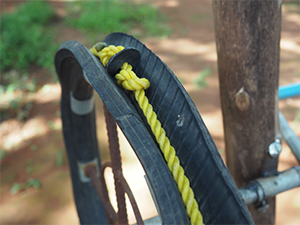Rope Pump

Worldwide some three million people now use rope pumps, of which 1.4 million reside in Africa where it is probably the fastest growing hand pump model. It is fit for family wells but, if management is organised, it can serve communities of up to 150 people.


Its high pumping capacity makes it popular for productive uses as car washing, life stock and small scale irrigation. For the same depth, the rope pump is three to five times cheaper than (imported) piston pumps. Some rope pump experiences: Nicaragua.
Of the 70,000 rope pumps installed since 1990, 80 % are used for Self-supply at family level. Families with a rope pump earn USD 220/year more than families without a pump. Ghana. Experiences with the first 200 rope pumps have been discouraging. 80 % did not function after one year because of lack of user involvement and errors in production and installation. The “wrong” introduction of the rope pump hampered the acceptance by the government for a long time and it took great efforts from organisations such as WaterAid and Victoria pumps to improve the “image” with better pumps and more user involvement. Ethiopia. After the introduction of the rope pump in 2005, local governments and NGOs distributed free pumps. Some workshops started to copy high quality pumps with low quality production and improper installation, such that sales went down.
In 2013 a training program was started to improve the rope pump quality and in 2014, 10,000 pumps were ordered by a local government. The rope pump is now part of the National policy to scale up water access with Self-supply. Tanzania. After the SHIPO SMART Centre introduced the rope pump in 2005, there now are 20 workshops producing pumps. Of the 10,000 pumps installed, 40 % are purchased by families.
